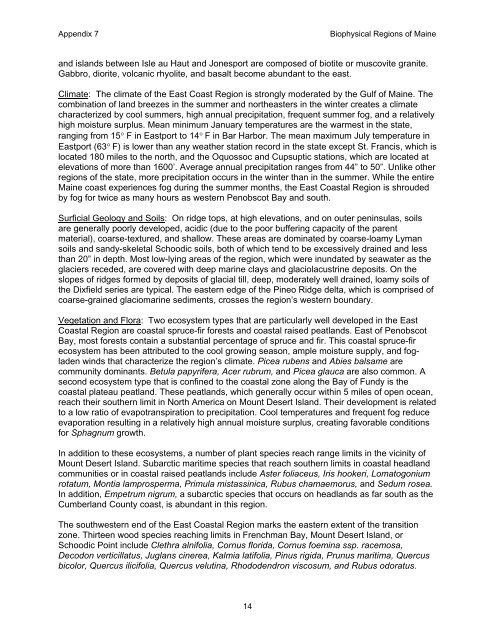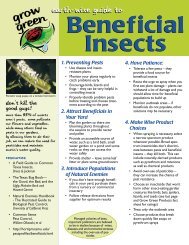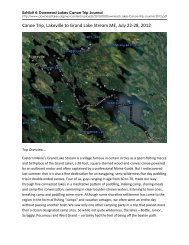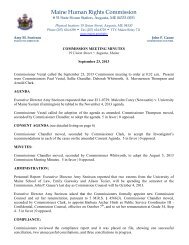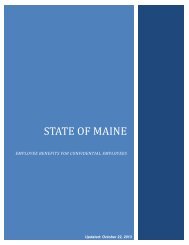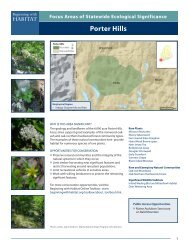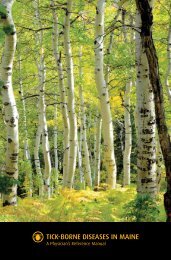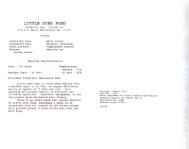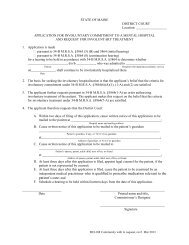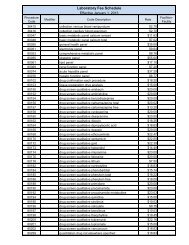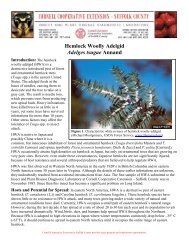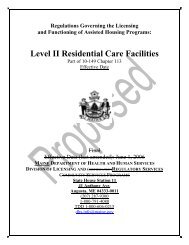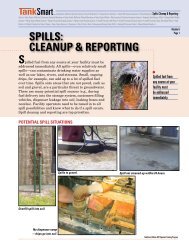BIOPHYSICAL REGIONS - Maine.gov
BIOPHYSICAL REGIONS - Maine.gov
BIOPHYSICAL REGIONS - Maine.gov
You also want an ePaper? Increase the reach of your titles
YUMPU automatically turns print PDFs into web optimized ePapers that Google loves.
Appendix 7 Biophysical Regions of <strong>Maine</strong><br />
and islands between Isle au Haut and Jonesport are composed of biotite or muscovite granite.<br />
Gabbro, diorite, volcanic rhyolite, and basalt become abundant to the east.<br />
Climate: The climate of the East Coast Region is strongly moderated by the Gulf of <strong>Maine</strong>. The<br />
combination of land breezes in the summer and northeasters in the winter creates a climate<br />
characterized by cool summers, high annual precipitation, frequent summer fog, and a relatively<br />
high moisture surplus. Mean minimum January temperatures are the warmest in the state,<br />
ranging from 15° F in Eastport to 14° F in Bar Harbor. The mean maximum July temperature in<br />
Eastport (63° F) is lower than any weather station record in the state except St. Francis, which is<br />
located 180 miles to the north, and the Oquossoc and Cupsuptic stations, which are located at<br />
elevations of more than 1600’. Average annual precipitation ranges from 44” to 50”. Unlike other<br />
regions of the state, more precipitation occurs in the winter than in the summer. While the entire<br />
<strong>Maine</strong> coast experiences fog during the summer months, the East Coastal Region is shrouded<br />
by fog for twice as many hours as western Penobscot Bay and south.<br />
Surficial Geology and Soils: On ridge tops, at high elevations, and on outer peninsulas, soils<br />
are generally poorly developed, acidic (due to the poor buffering capacity of the parent<br />
material), coarse-textured, and shallow. These areas are dominated by coarse-loamy Lyman<br />
soils and sandy-skeletal Schoodic soils, both of which tend to be excessively drained and less<br />
than 20” in depth. Most low-lying areas of the region, which were inundated by seawater as the<br />
glaciers receded, are covered with deep marine clays and glaciolacustrine deposits. On the<br />
slopes of ridges formed by deposits of glacial till, deep, moderately well drained, loamy soils of<br />
the Dixfield series are typical. The eastern edge of the Pineo Ridge delta, which is comprised of<br />
coarse-grained glaciomarine sediments, crosses the region’s western boundary.<br />
Vegetation and Flora: Two ecosystem types that are particularly well developed in the East<br />
Coastal Region are coastal spruce-fir forests and coastal raised peatlands. East of Penobscot<br />
Bay, most forests contain a substantial percentage of spruce and fir. This coastal spruce-fir<br />
ecosystem has been attributed to the cool growing season, ample moisture supply, and fogladen<br />
winds that characterize the region’s climate. Picea rubens and Abies balsame are<br />
community dominants. Betula papyrifera, Acer rubrum, and Picea glauca are also common. A<br />
second ecosystem type that is confined to the coastal zone along the Bay of Fundy is the<br />
coastal plateau peatland. These peatlands, which generally occur within 5 miles of open ocean,<br />
reach their southern limit in North America on Mount Desert Island. Their development is related<br />
to a low ratio of evapotranspiration to precipitation. Cool temperatures and frequent fog reduce<br />
evaporation resulting in a relatively high annual moisture surplus, creating favorable conditions<br />
for Sphagnum growth.<br />
In addition to these ecosystems, a number of plant species reach range limits in the vicinity of<br />
Mount Desert Island. Subarctic maritime species that reach southern limits in coastal headland<br />
communities or in coastal raised peatlands include Aster foliaceus, Iris hookeri, Lomatogonium<br />
rotatum, Montia lamprosperma, Primula mistassinica, Rubus chamaemorus, and Sedum rosea.<br />
In addition, Empetrum nigrum, a subarctic species that occurs on headlands as far south as the<br />
Cumberland County coast, is abundant in this region.<br />
The southwestern end of the East Coastal Region marks the eastern extent of the transition<br />
zone. Thirteen wood species reaching limits in Frenchman Bay, Mount Desert Island, or<br />
Schoodic Point include Clethra alnifolia, Cornus florida, Cornus foemina ssp. racemosa,<br />
Decodon verticillatus, Juglans cinerea, Kalmia latifolia, Pinus rigida, Prunus maritima, Quercus<br />
bicolor, Quercus ilicifolia, Quercus velutina, Rhododendron viscosum, and Rubus odoratus.<br />
14


